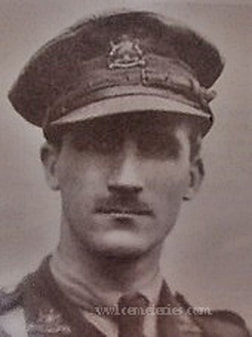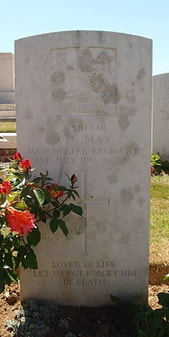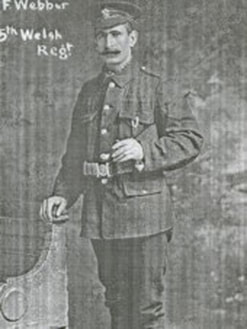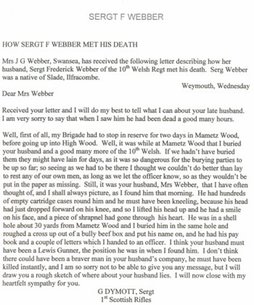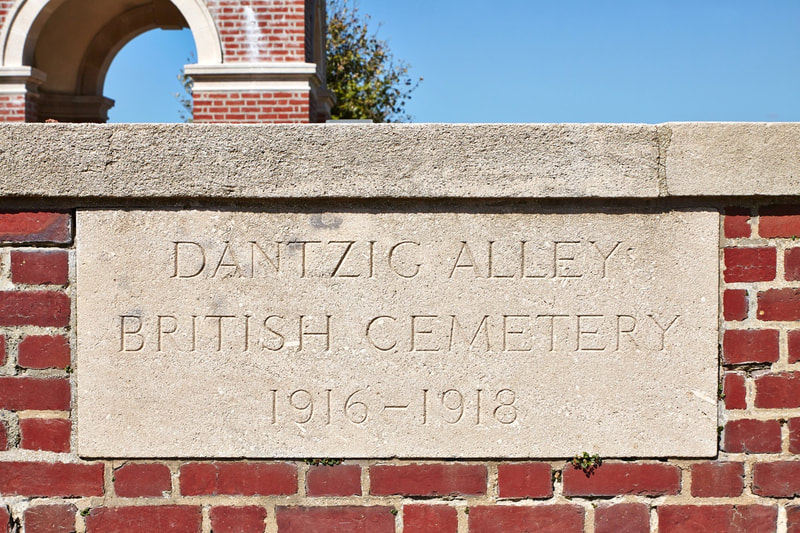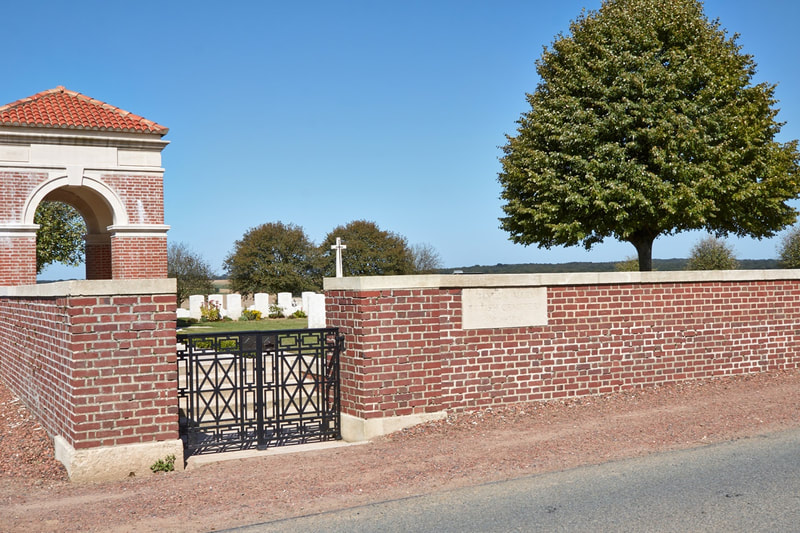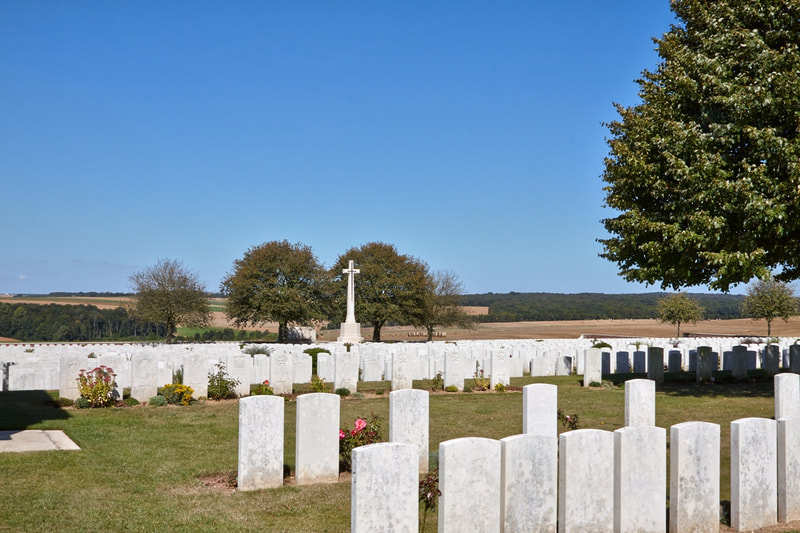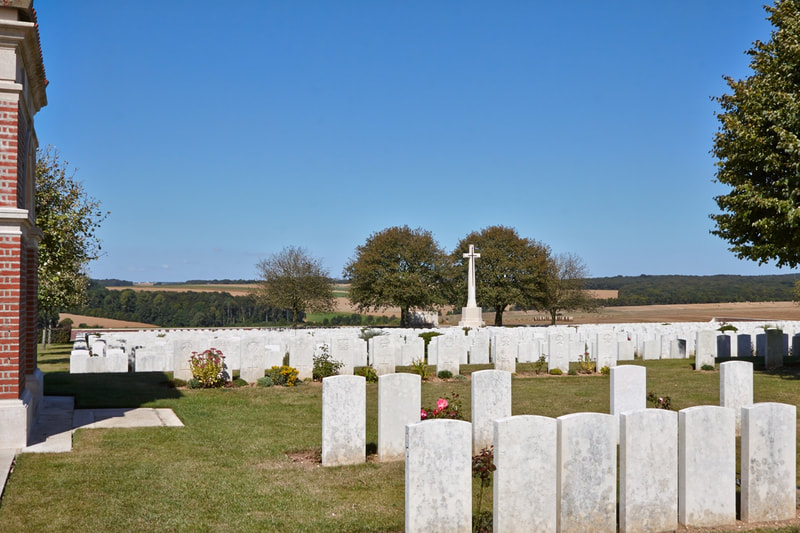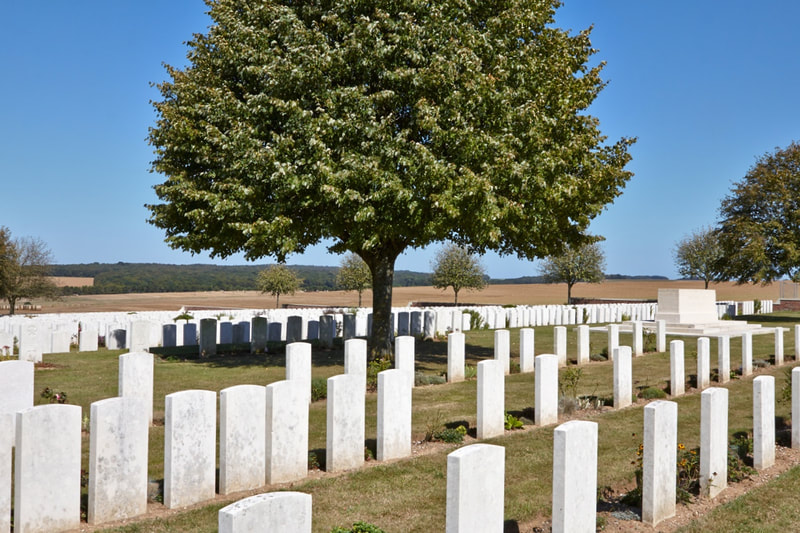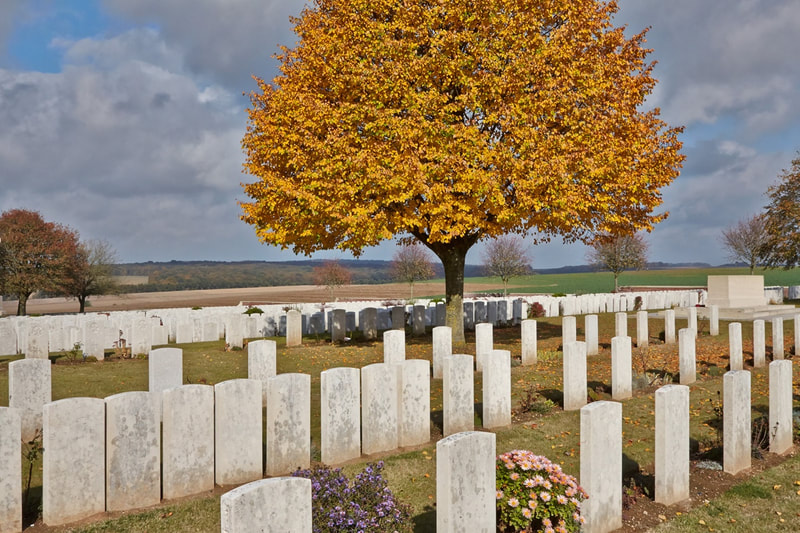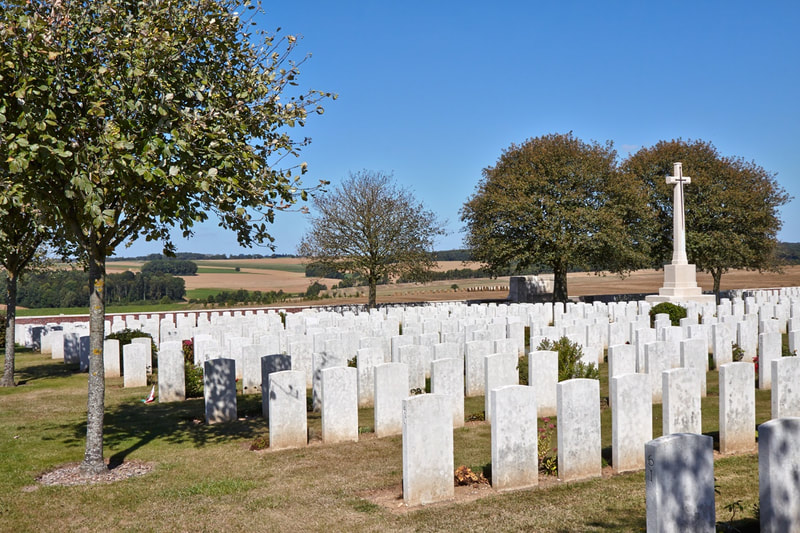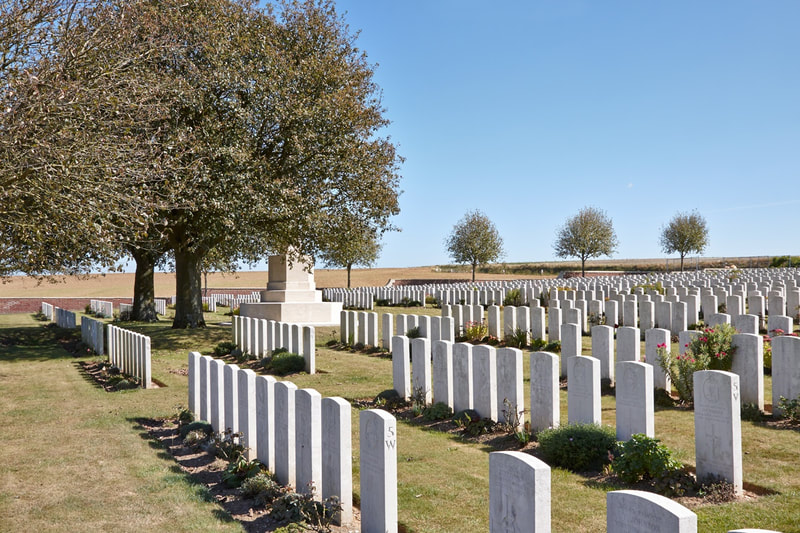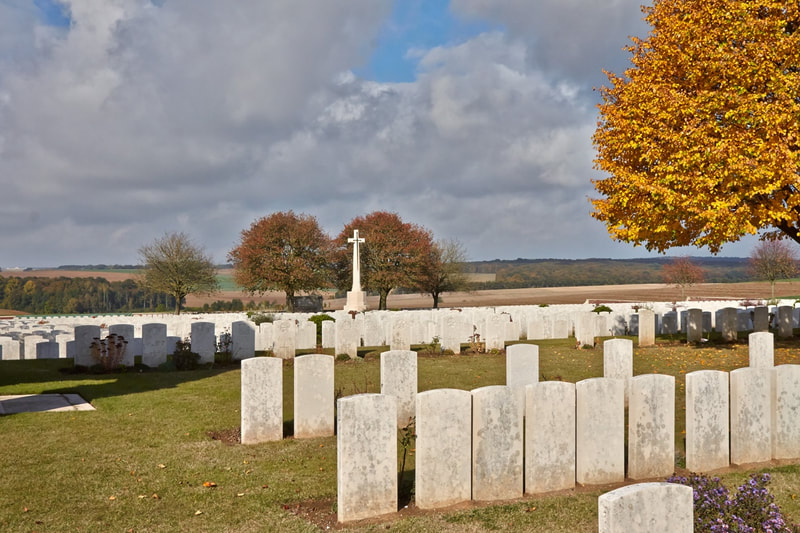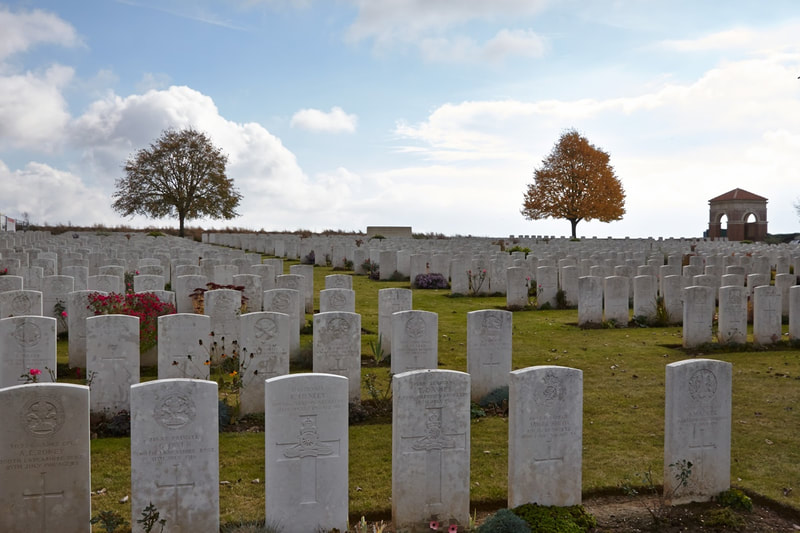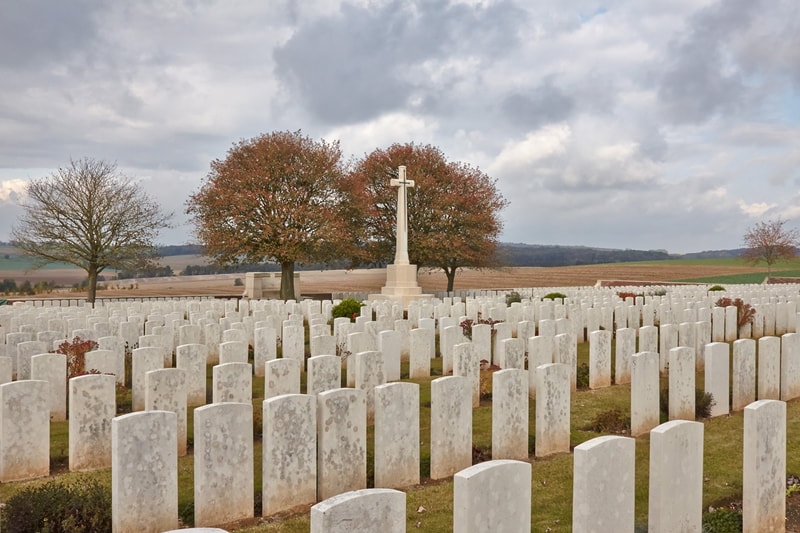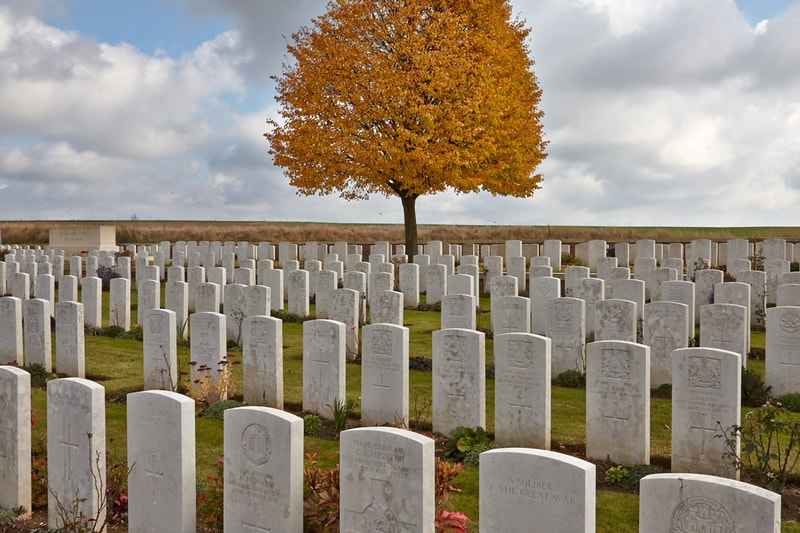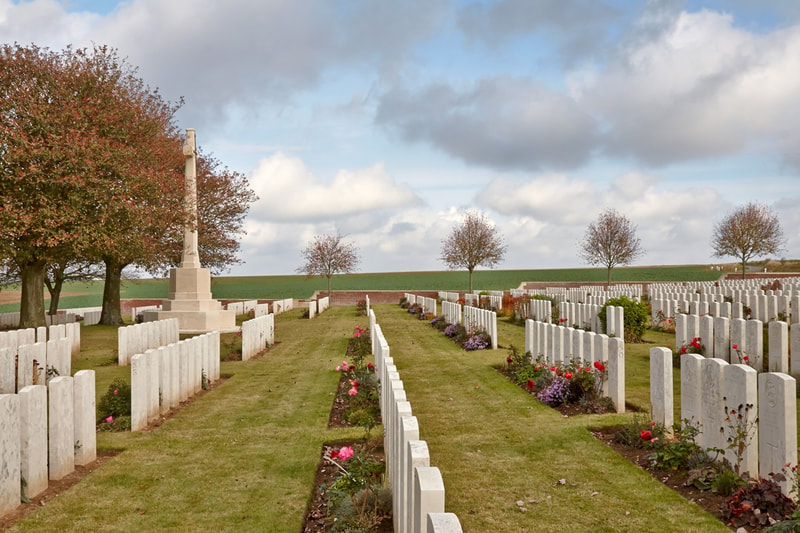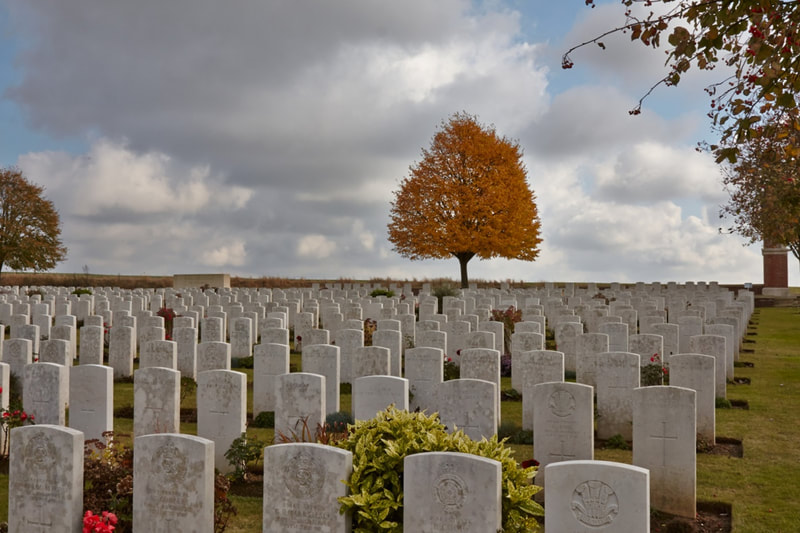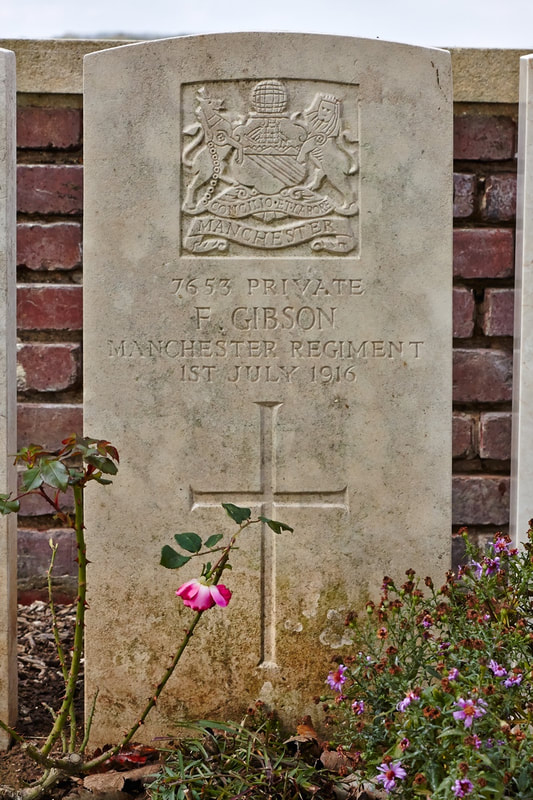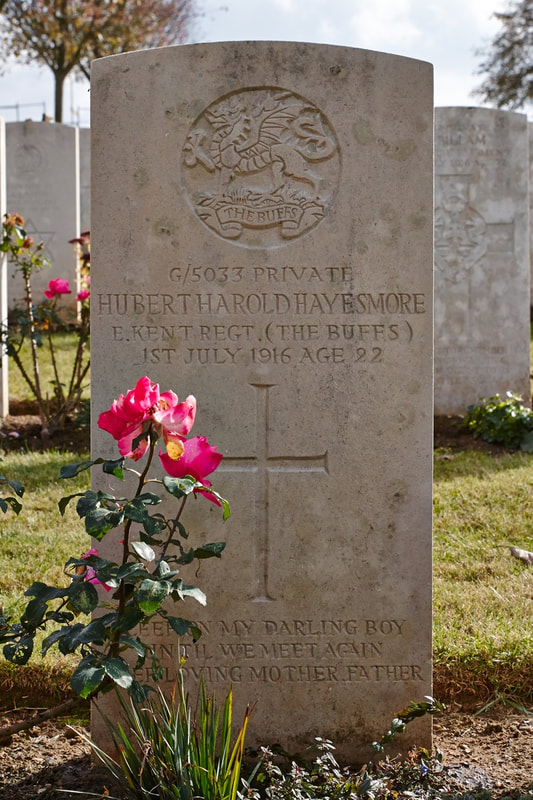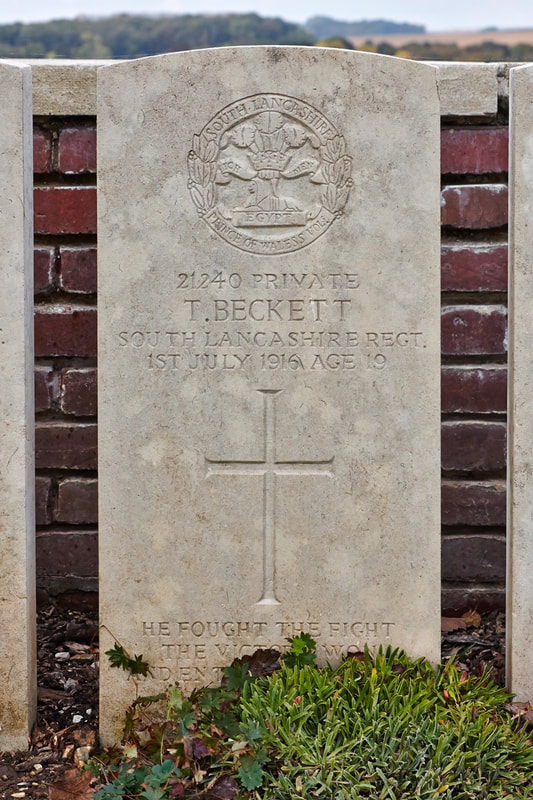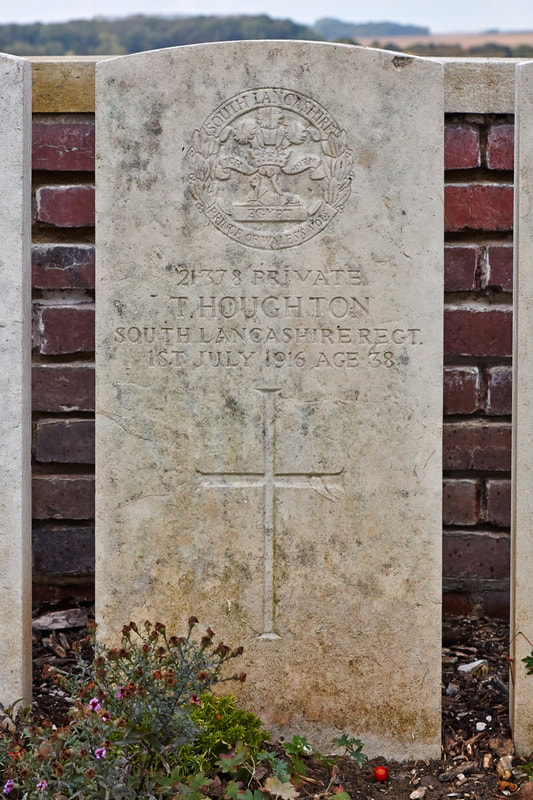Dantzig Alley British Cemetery
Roll of Honour
M - Z
Captain
Charles Campbell May, Mentioned in Despatches
"B" Coy. 22nd Bn. Manchester Regiment
1st July 1916, aged 27.
Plot II. B. 3.
Son of Major and Mrs. C. E. May, of New Zealand and London; husband of Bessie Maude Earles (formerly May), of 1, Rue Hwys Mans, Paris.
His headstone bears the inscription "Loved In Life Let Us Not Forget Him In Death"
Charles Campbell May, Mentioned in Despatches
"B" Coy. 22nd Bn. Manchester Regiment
1st July 1916, aged 27.
Plot II. B. 3.
Son of Major and Mrs. C. E. May, of New Zealand and London; husband of Bessie Maude Earles (formerly May), of 1, Rue Hwys Mans, Paris.
His headstone bears the inscription "Loved In Life Let Us Not Forget Him In Death"
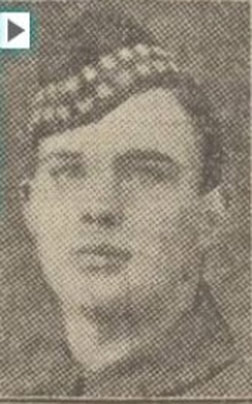
S/8267 Private
J. McIntosh
2nd Bn. Gordon Highlanders
1st July 1916.
Plot II. G. 5.
J. McIntosh
2nd Bn. Gordon Highlanders
1st July 1916.
Plot II. G. 5.
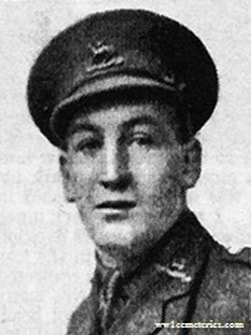
Second Lieutenant
Francis John Miller
7th Bn. The Queen's (Royal West Surrey Regiment)
1st July 1916, aged 19.
Plot III. O. 5.
Son of Joseph William and Eliza Miller, of "Sunnycroft," Penrith Rd., Boscombe, Bournemouth. Native of Buckhurst Hill, Essex.
Francis John Miller
7th Bn. The Queen's (Royal West Surrey Regiment)
1st July 1916, aged 19.
Plot III. O. 5.
Son of Joseph William and Eliza Miller, of "Sunnycroft," Penrith Rd., Boscombe, Bournemouth. Native of Buckhurst Hill, Essex.
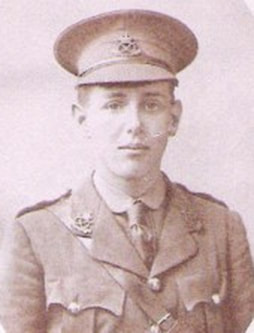
Second Lieutenant
William Henry Ratcliffe
4th Bn. Attached. 1st Bn. South Staffordshire Regiment.
1st July 1916.
Special Memorial 7.
Son of Thomas S. Ratcliffe, of The Sheiling, Cyprus Rd., Mapperley Park, Nottingham.
Picture courtesy of Sheryl Ratcliffe
William Henry Ratcliffe
4th Bn. Attached. 1st Bn. South Staffordshire Regiment.
1st July 1916.
Special Memorial 7.
Son of Thomas S. Ratcliffe, of The Sheiling, Cyprus Rd., Mapperley Park, Nottingham.
Picture courtesy of Sheryl Ratcliffe
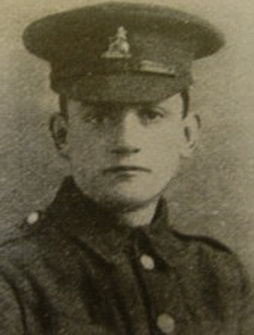
13617 Lance Corporal
Edwin Cyril Laffan Read
8th Bn. Norfolk Regiment.
1st July 1916.
Plot VIII. A. 3.
Edwin Cyril Laffan Read
8th Bn. Norfolk Regiment.
1st July 1916.
Plot VIII. A. 3.
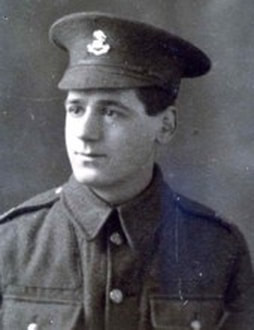
16788 Private
Arthur Todd
18th Bn. The King's, (Liverpool Regiment)
1st July 1916, aged 21.
Special Memorial 21.
Son of James G. and Agnes Maria Todd, of 68, Thornycroft Rd., Liverpool.
Originally buried at Vernon Street Cemetery, Carnoy.
Arthur Todd
18th Bn. The King's, (Liverpool Regiment)
1st July 1916, aged 21.
Special Memorial 21.
Son of James G. and Agnes Maria Todd, of 68, Thornycroft Rd., Liverpool.
Originally buried at Vernon Street Cemetery, Carnoy.
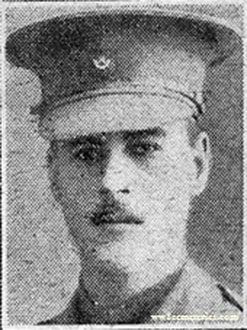
Second Lieutenant
W. B. Todd-Naylor
8th Bn. King's Royal Rifle Corps
24th August 1916.
Plot I. A. 56.
W. B. Todd-Naylor
8th Bn. King's Royal Rifle Corps
24th August 1916.
Plot I. A. 56.
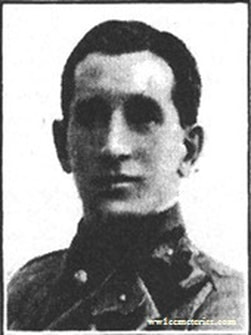
Second Lieutenant
E. S. Turner
116th Siege Battery, Royal Garrison Artillery
21st August 1916.
Vernon Street Cemetery, Memorial 55.
E. S. Turner
116th Siege Battery, Royal Garrison Artillery
21st August 1916.
Vernon Street Cemetery, Memorial 55.
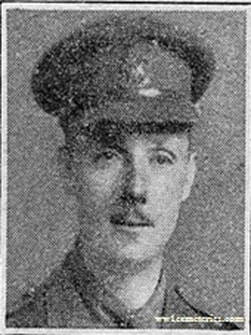
Major
G. E. Venner
1st Bn. attached to 3rd Bn. Sherwood Foresters (Notts and Derby Regiment)
8th July 1916.
Plot II. M. 3.
G. E. Venner
1st Bn. attached to 3rd Bn. Sherwood Foresters (Notts and Derby Regiment)
8th July 1916.
Plot II. M. 3.
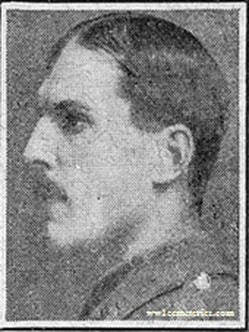
Captain
John Robert Walpole
7th Bn. The Queen's (Royal West Surrey Regiment)
1st July 1916, aged 34.
Plot VIII. N. 3.
Son of Sir Charles and Lady Walpole, of 4, Kensington Court, London. Native of Chobham, Surrey.
John Robert Walpole
7th Bn. The Queen's (Royal West Surrey Regiment)
1st July 1916, aged 34.
Plot VIII. N. 3.
Son of Sir Charles and Lady Walpole, of 4, Kensington Court, London. Native of Chobham, Surrey.
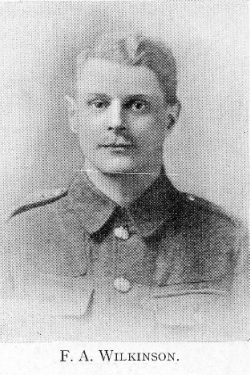
8336 Sergeant
Frederick Arthur Wilkinson
"C" Company, 17th Bn. Manchester Regiment
1st July 1916, aged 26.
Plot VIII. W. 8.
Son of Thomas H. and Sarah J. Wilkinson, of "Waltham," Wilmslow, Cheshire.
The information below supplied by 'The Ellesmerian Club', the alumni organisation for Ellesmere College where Frederick was a pupil.
Frederick Arthur Wilkinson
"C" Company, 17th Bn. Manchester Regiment
1st July 1916, aged 26.
Plot VIII. W. 8.
Son of Thomas H. and Sarah J. Wilkinson, of "Waltham," Wilmslow, Cheshire.
The information below supplied by 'The Ellesmerian Club', the alumni organisation for Ellesmere College where Frederick was a pupil.
Frederick Arthur Wilkinson, born 23rd September 1889, was the son of Thomas Howarth and Sarah Jane Wilkinson and was admitted to Ellesmere College in January 1903 where he boarded in the ‘Harold’ dormitory, and was placed in Upper II under the tutelage of Mr Warth. He stayed for seven terms, leaving in April 1905.
In the summer of 1904 he passed Arithmetic, Religious Knowledge, History and English in the Oxford Examinations. He was also graded as “good” in the class firing with a score of 113 out of 200.
His sporting feats were limited to playing football for his dormitory for whom, in March 1905, in the semi-final he scored a goal in the 9-0 demolition of the ‘Arthur’ dormitory. In the final he contributed to the victory with “a good centre from which a goal was scored”.
His father is described as a cloth salesman in the Census of 1891 and in that of 1911 as Manager, shipping cotton goods. There were two elder sisters, Agnes and Edith, in the family which lived all its life in the Wilmslow area.
On the outbreak of war it was resolved to raise and equip a battalion from the many men who “would be found in the warehouses and offices of Manchester”. Response to the appeal was such that the single battalion became the 90th Brigade, consisting of four battalions, numbered in due course the 16th to the 19th. “The Manchester Pals” had been formed and Frederick was one of them as he had enlisted on 2nd September. Prior to this he had been employed as a clerk at John Dugdale & Brothers, Manufacturers and Merchants in Manchester. Private Wilkinson, Service No: 8336, 17th Battalion, the Manchester Regiment was promoted Sergeant only three weeks after enlisting – this would suggest previous military experience with the Territorials.
After training in Heaton Park, Grantham and Larkhill, the Brigade transferred to France on 8th November 1915. Frederick had embarked the day prior with the advance transport section. Its first major battle was on the 1stJuly 1916. The achievements of the eight “Pals” battalions, four from Manchester and four from Liverpool, were an isolated success on this “Big Day” for they captured their objective, Montauban. It was an expensive victory.
“C” Company were in the second line of attack when they moved forward at 08.30 in extended line formation and they took heavy casualties from machine gun fire from the direction of Mametz. The advance, however, continued and Montauban was seized.
Preparations now had to be made in the captured trenches to face the inevitable counterattack. Lewis gun posts were established at several points. One, on the sunken road leading to Quarry Cemetery, was wiped out, killing Sergeant Wilkinson and his crew. Two days later, at roll call, it was discovered that 358 men out of 900 were dead.
Frederick was buried near to where he fell “5½ miles E. of Albert”. He was one of three Ellesmerians to die in action that day. His body was later exhumed and reburied at Danzig Alley British Cemetery, Mametz. He left his effects and his medals, the British War Medal and the Victory Medal to his sister, Agnes Lilian Wilkinson, spinster. In 1920 his father wrote to military records about the non-appearance of the “plaque of commemoration”, but there is no indication of a reply in the records or the arrival of the plaque.
Frederick’s life is commemorated on the Wilmslow War Memorial and the memorial at Ellesmere College.
A lifelong friend paid tribute to Frederick in The Alderley & Wilmslow Advertiser a few weeks after his death. He wrote: The Great War goes on its course, and, one by one, friends and comrades are taken by the Great Reaper. And now he has claimed Sergeant Frederick Arthur Wilkinson, late of Waltham, Wilmslow and only those who had the privilege of his friendship know how splendid a victim has now fallen to the sickle. Our first days at a preparatory school were spent together and very pleasant their memory; but best of all the long summer days, when school did not claim us, spent, most likely, in the winding Bollin valley – adventurous days when every bend and shallow in the river had its name and usefulness. He was always a good playfellow, a good comrade; that was at all times his strongest characteristic because was possessed of that perfect unselfishness which is the foundation of all friendship. On his return, from college and tennis claimed him, he was one of the strongest players of the Lindow Club; but always the game to him was more than the prize and the comradeship of the game most of all. But one saw it most strongly in those first enthusiastic days of the Wilmslow Hockey Club, for which he acted for some time as secretary, that brilliantly performing cub whose career ended so prematurely at the call of the Greater Game. Next to the members of his own family it is surely among his old hockey friends that his loss will be felt most keenly. One of the first of us to join the Army, he enjoyed it as much as he had enjoyed tennis and hockey and was equally keen. Very soon a sergeant, he was offered a commission in another battalion. But he was too valuable to be spared. Offered a commission in his own battalion, he refused it saying he did not desire to hold such a position over those he had come to regard as his friends. So a sergeant he remained until the end, and to him the greater honour. It is hard to believe that only six weeks ago I saw him when he was on short leave from the trenches, full of splendid life. When someone enquired if he were sorry to go back “It is hard to leave home again”, he said, ”very hard but I am going back among good pals and life is worth living out there. I wouldn’t be out of it”. And in that spirit he bade us goodbye, and in that spirit he died, an English gentleman in the service of his King. And his strong, young body now lies at rest now “in some corner of a foreign field that is forever England”.
In the summer of 1904 he passed Arithmetic, Religious Knowledge, History and English in the Oxford Examinations. He was also graded as “good” in the class firing with a score of 113 out of 200.
His sporting feats were limited to playing football for his dormitory for whom, in March 1905, in the semi-final he scored a goal in the 9-0 demolition of the ‘Arthur’ dormitory. In the final he contributed to the victory with “a good centre from which a goal was scored”.
His father is described as a cloth salesman in the Census of 1891 and in that of 1911 as Manager, shipping cotton goods. There were two elder sisters, Agnes and Edith, in the family which lived all its life in the Wilmslow area.
On the outbreak of war it was resolved to raise and equip a battalion from the many men who “would be found in the warehouses and offices of Manchester”. Response to the appeal was such that the single battalion became the 90th Brigade, consisting of four battalions, numbered in due course the 16th to the 19th. “The Manchester Pals” had been formed and Frederick was one of them as he had enlisted on 2nd September. Prior to this he had been employed as a clerk at John Dugdale & Brothers, Manufacturers and Merchants in Manchester. Private Wilkinson, Service No: 8336, 17th Battalion, the Manchester Regiment was promoted Sergeant only three weeks after enlisting – this would suggest previous military experience with the Territorials.
After training in Heaton Park, Grantham and Larkhill, the Brigade transferred to France on 8th November 1915. Frederick had embarked the day prior with the advance transport section. Its first major battle was on the 1stJuly 1916. The achievements of the eight “Pals” battalions, four from Manchester and four from Liverpool, were an isolated success on this “Big Day” for they captured their objective, Montauban. It was an expensive victory.
“C” Company were in the second line of attack when they moved forward at 08.30 in extended line formation and they took heavy casualties from machine gun fire from the direction of Mametz. The advance, however, continued and Montauban was seized.
Preparations now had to be made in the captured trenches to face the inevitable counterattack. Lewis gun posts were established at several points. One, on the sunken road leading to Quarry Cemetery, was wiped out, killing Sergeant Wilkinson and his crew. Two days later, at roll call, it was discovered that 358 men out of 900 were dead.
Frederick was buried near to where he fell “5½ miles E. of Albert”. He was one of three Ellesmerians to die in action that day. His body was later exhumed and reburied at Danzig Alley British Cemetery, Mametz. He left his effects and his medals, the British War Medal and the Victory Medal to his sister, Agnes Lilian Wilkinson, spinster. In 1920 his father wrote to military records about the non-appearance of the “plaque of commemoration”, but there is no indication of a reply in the records or the arrival of the plaque.
Frederick’s life is commemorated on the Wilmslow War Memorial and the memorial at Ellesmere College.
A lifelong friend paid tribute to Frederick in The Alderley & Wilmslow Advertiser a few weeks after his death. He wrote: The Great War goes on its course, and, one by one, friends and comrades are taken by the Great Reaper. And now he has claimed Sergeant Frederick Arthur Wilkinson, late of Waltham, Wilmslow and only those who had the privilege of his friendship know how splendid a victim has now fallen to the sickle. Our first days at a preparatory school were spent together and very pleasant their memory; but best of all the long summer days, when school did not claim us, spent, most likely, in the winding Bollin valley – adventurous days when every bend and shallow in the river had its name and usefulness. He was always a good playfellow, a good comrade; that was at all times his strongest characteristic because was possessed of that perfect unselfishness which is the foundation of all friendship. On his return, from college and tennis claimed him, he was one of the strongest players of the Lindow Club; but always the game to him was more than the prize and the comradeship of the game most of all. But one saw it most strongly in those first enthusiastic days of the Wilmslow Hockey Club, for which he acted for some time as secretary, that brilliantly performing cub whose career ended so prematurely at the call of the Greater Game. Next to the members of his own family it is surely among his old hockey friends that his loss will be felt most keenly. One of the first of us to join the Army, he enjoyed it as much as he had enjoyed tennis and hockey and was equally keen. Very soon a sergeant, he was offered a commission in another battalion. But he was too valuable to be spared. Offered a commission in his own battalion, he refused it saying he did not desire to hold such a position over those he had come to regard as his friends. So a sergeant he remained until the end, and to him the greater honour. It is hard to believe that only six weeks ago I saw him when he was on short leave from the trenches, full of splendid life. When someone enquired if he were sorry to go back “It is hard to leave home again”, he said, ”very hard but I am going back among good pals and life is worth living out there. I wouldn’t be out of it”. And in that spirit he bade us goodbye, and in that spirit he died, an English gentleman in the service of his King. And his strong, young body now lies at rest now “in some corner of a foreign field that is forever England”.
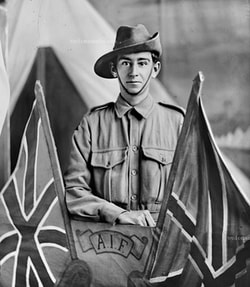
2505 Private
Cecil Carrick Wotton
29th Bn. Australian Infantry, A. I. F.
23rd November 1916, aged 21.
Plot IX. P. 3.
A 21 year old gasfitter, he mobilised for War Service in August 1914 and embarked at Cairns, Queensland on 8 August 1914 for Garrison Duty on Thursday Island. On 14 August 1914 he enlisted for service outside Australia and embarked from Thursday Island on 16 August to take part in the capture of German New Guinea. He joined the Australian Naval and Military Expeditionary Force in September but returned to Townsville on 18 September 1914 not having participated in the capture of German New Guinea due to trouble caused by the firemen on the troopship. He was discharged on 18 September 1914 and enlisted in the AIF on 21 December 1914 and given the service number of 276. He embarked for overseas with A Company, 25th Battalion from Brisbane on 29 June 1915 aboard HMAT Aeneas but returned to Australia medically unfit on 25 September 1915. He re-embarked with service number 2505 with the 4th Reinforcements of the 29th Battalion from Melbourne on 14 March 1916 aboard HMAT Aeneas. While undergoing further training in Egypt, he transferred to the 18th Company Australian Army Service Corps and went on to serve with the 5th Divisional Train in France. Pte Wotton was killed in action on 23 November 1916.
Cecil Carrick Wotton
29th Bn. Australian Infantry, A. I. F.
23rd November 1916, aged 21.
Plot IX. P. 3.
A 21 year old gasfitter, he mobilised for War Service in August 1914 and embarked at Cairns, Queensland on 8 August 1914 for Garrison Duty on Thursday Island. On 14 August 1914 he enlisted for service outside Australia and embarked from Thursday Island on 16 August to take part in the capture of German New Guinea. He joined the Australian Naval and Military Expeditionary Force in September but returned to Townsville on 18 September 1914 not having participated in the capture of German New Guinea due to trouble caused by the firemen on the troopship. He was discharged on 18 September 1914 and enlisted in the AIF on 21 December 1914 and given the service number of 276. He embarked for overseas with A Company, 25th Battalion from Brisbane on 29 June 1915 aboard HMAT Aeneas but returned to Australia medically unfit on 25 September 1915. He re-embarked with service number 2505 with the 4th Reinforcements of the 29th Battalion from Melbourne on 14 March 1916 aboard HMAT Aeneas. While undergoing further training in Egypt, he transferred to the 18th Company Australian Army Service Corps and went on to serve with the 5th Divisional Train in France. Pte Wotton was killed in action on 23 November 1916.

